
I’m driving along the two-lane highway 40 in Northeast Alabama. A few of hours earlier Tony Lyza and Ryan Wade, tornado researchers at the University Alabama, Huntsville, are giving me directions. I had asked him if you could still see the tracks from 2011 tornadoes. He then begins to give me directions through rural Alabama including a warning about the area known as Meth Mountain. The directions end with statement about watching out for the meatpacking sign. Sure enough, I see the sign advertising meatpacking services on my right as I am driving along the small highway through Alabama forest. The forest stops and I see nothing but cleared lands with cattle and farms. I say to my wife, “I though this was where it was supposed to be.” All I see is the typical agriculture that dots the Southern landscape. As I look closer the houses are all newer than just a mile back and the few trees both smaller and scragglier. Then it hits me, I am in the damage swath of EF5 tornado. Four and half years later the landscape still bears the witness of the 2011 tornado super outbreak.
The tornado season of 2011 was one of the most deadly in U.S. history with 59 killer tornadoes in 14 states. The 2011 tornado season lead to 552 total fatalities. Most of those occurred in Alabama and Missouri.
| State | Total Tornado Related Deaths in 2011 | |
| Alabama | 242 | |
| Missouri | 159 | |
| Tennessee | 33 | |
| Mississippi | 32 | |
| North Carolina | 24 | |
| Georgia | 16 | |
| Oklahoma | 14 | |
| Arkansas | 12 | |
Since Mississippi in 1971, no state had witnessed more than 100 tornado fatalities in a single year. You need to go back to 1953 to find more than two states. The three most deadly tornadoes of 2011 were the Joplin, MO EF5 tornado that took 159 lives, the Western Alabama EF5 that claimed 72, and the Tuscaloosa-Birmingham EF4 tornado that killed 64. Six of the top ten deadliest tornadoes that year occurred in Alabama. These tornadoes themselves were the single most deadly tornado days since March 18, 1925.

The most alarming part of these high number of deaths it that they occurred on a backdrop of decreasing injury and death from tornadoes over the last several decades. Up until the 1950’s fatalities per million people average around 2-3 per year and well over 200 annually. After 1975, annual tornado related deaths shrink to just a couple of dozen per and less than 0.25 per million people. Take the table below comparing high tornado fatality years against the 10-year average surrounding these high years.
| Year | Fatalities | 10 Year Average | % Greater Than Average |
| 1908 | 523 | 286 | 183% |
| 1917 | 588 | 253 | 232% |
| 1925 | 805 | 238 | 338% |
| 1936 | 555 | 183 | 303% |
| 1953 | 515 | 118 | 436% |
| 1965 | 301 | 96 | 314% |
| 1974 | 348 | 83.9 | 415% |
| 1998 | 130 | 54.5 | 239% |
| 2011 | 552 | 57.6 | 958% |
The 2011 event had 958% greater total fatalities than the decade before.
It is reasonable to attribute this to the increase vulnerability in Southern States. For example, we have more mobile homes. In the 25 years prior, more tornado-related deaths in the Southeast U.S. did occur in mobile homes. In the decade before 2011, one-half of all fatalities occurred in mobile homes. But in 2011, the tornadoes were indiscriminate. Percentages reflect the actually representations of structures across the landscape.
 An analysis conducted by Simmons and Sutter (2012)* found that none of these societal issues unique to the South lead to this high fatality count in 2011. Indeed, their analyses suggest that fatalities were to be expected from such an extreme weather event.
An analysis conducted by Simmons and Sutter (2012)* found that none of these societal issues unique to the South lead to this high fatality count in 2011. Indeed, their analyses suggest that fatalities were to be expected from such an extreme weather event.
As I continue to drive down 40, I reflect on how I almost overlooked the imprint of the 2011 tornado that hit here. New buildings and planted fields are a testament to the South’s resilience in the face of adversity. Indeed, Simmons and Sutter found that there is an economic boom and increases in population growth rates in local communities impacted by tornadoes even if the last emotional imprint of such an event never goes away.
*indeed all the stats in this post come from their wonderful book Deadly Season.
